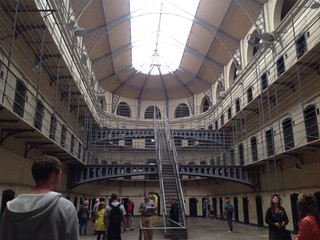What an unusual title for a post! Who wants to visit a gaol? Apparently Miss W. did.
Our day started after a warm restless night with Miss W. and I catching the local Dublin bus back out to the airport where we had a late breakfast and picked up our car. Now from our previous travels, you know what Miss W. is like when driving. She had planned out the route to get us back to our hotel about 12 minutes drive from the airport.
Head towards Santry on the R132, At Santry, turn right onto R104, then left on R108, then left again onto R102 and finally right onto Drumcondra Road and the hotel.
Guess what happened? At Santry we couldn’t find the R104, so we just kept following the main road for about 10 minutes. Luckily much of it was the same route our bus had taken so we knew we weren’t far from the hotel. Out came the ipad with the Dublin Map Miss W. had downloaded before leaving Australia. We were in Griffith Avenue only about 100 metres from Drumcondra Road where we needed to be but we were coming in from the eastern side instead of the western side as Miss W had planned. Thank goodness for the ipad app.
Car now parked at the hotel and time to head out on the number 16 bus again this time going into Dublin central city area of O ‘Connell Street. One thing I’ve noticed is that the buildings are all joined together and very narrow frontages. Buses and cyclists have a separate lane on the road, but I pity some of the cyclists when a huge double decker bus pulls up behind them. We were sitting at the front seat on the top deck and it looked like we had run over the cyclist we were so close.
We then walked over the bridge across the River Liffey to catch another bus to get to Kilmainham Gaol.
This is a very famous gaol in relation to Irish history, from the mid 1700’s through to the early 20th century. Many famous Irish rebels have been through the gaol and Miss W. was wondering if one of her convict relatives was in there during 1847. She might find out more about him William Jackson senior age 58 and William Jackson junior age 13 who were both tried with Rebecca Jackson age 16 in County Donegal on 1 January 1847. They were charged with larceny – stealing wearing apparel. But more about them when we visit the National Archives on Thursday. But if we don’t find anything, our tour guide gave Miss W the name and email for a researcher at the gaol.
Back to the gaol…. It was built in the same style as that at Port Arthur in Tasmania. But Kilmainham was used up until the early 20th century so it is in quite good repair. You can still see the roof areas within the gaol as well as the exercise and chapel areas. It was still a quiet gaol in that inmates were in their cells usually 23 hours per day and an hour in the exercise yard. There was no talking to other inmates even if on a working party.
But if you were one of the more high ranking rebels and had money to spare there were some larger cells where you could actually have your family stay and or visit for a certain price.
The youngest convicts kept there during the 1800’s were aged 5 and 7 – if you were old enough to steal to help your family survive, then you were old enough to take the consequences.

I know many students might be reading this post, so I would like your opinion.
What is the youngest age you think should be in gaol? Why? Where should children be sent if they break the law?
PS From our previous post, have you guessed yet that we are in the land where little green men look for pots of gold at the end of the rainbows ….. yes, we are in Ireland.
Wow! I can’t imagine kids being sent to prison at such a young age. Most kids that are little don’t understand what it means to steal. I have visited Alcatraz, and I can’t imagine being a little kid in prison there.
Thanks for sharing.
Kat 😎